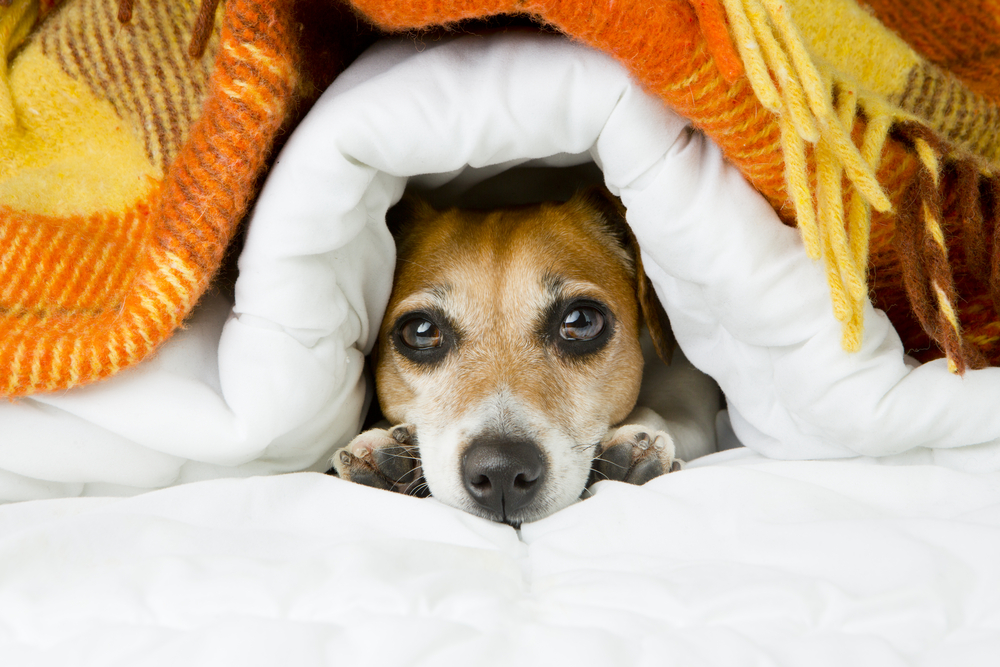Crack! Boom! Whizz! Pop!
Loud and sudden sounds are the bane of dogs and their people. Dogs are startled by loud, unexpected sounds and can develop debilitating fears related to them. People hate seeing their dogs frightened and trembling in response to thunder and lightning; the whizzing, flaring lights, and explosions of fireworks; or the bang of a gun.
Sound sensitivity is innate in dogs—it’s a protective response that can alert them to danger—but some have an extreme reaction to loud noises. That oversensitivity to sound, which can develop at any age and in any breed or mix, can overwhelm them, leading to fear, anxiety, and stress. It can be linked to a specific event or build over time.
If your dog has a fear of loud noises, you can put together a plan to help him stay calm. Depending on the particular fear, it may involve keeping a weather eye on thunderstorm activity, layering in medication prescribed by your veterinarian, and preparing a safe room where your dog can ride out the event in peace.
Remember that dogs take cues from us on whether to relax or panic. The less worried and more relaxed you are, the less worried and more relaxed your dog will be. Having a plan can help you be confident about keeping your dog comfortable and in turn help to communicate to your dog the sense that “all is well.” Here’s what to do.
Set up a relaxation room where your dog can retreat. It should contain food and water, some favorite food puzzles or other toys, and a cozy bed. Ideally, it will be an interior room with no windows, such as a closet, bathroom, or basement. Otherwise, close curtains or blinds to help block out light and sound. Playing calming music and/or turning on a white noise machine can also reduce exposure to scary noises. Spray or diffuse Adaptil in the room to send a chemical calming message. You can also spritz the room with soothing scents of lavender or chamomile. Leave the door open so your dog can enter and exit on her own and doesn’t feel trapped.
During thunderstorm season, pay attention to weather reports. That way, if you’re home, you can take your dog to the relaxation room before a storm starts. Do the same if you know that a fireworks show is planned for a certain time or hunters will be in the area during the day.
Don’t force dogs who are hiding to come out from under the bed or behind the sofa. If they are afraid and feel cornered or confronted, they may bite. It’s okay to briefly and gently encourage them to come out on their own but never try to pull them out.
You can comfort your dog if he’s scared, but avoid doing so in a way that’s unusual. Hovering, jump up to comfort him immediately after a crack of lightning, or using baby talk can signal to your dog that you’re feeling nervous or on edge, and that can make him worried, too. Instead, be calm, give him space, and redirect his attention to a food puzzle or other activity. Practice deep breathing, mindfulness, or some other relaxing activity—reading or watching a feel-good TV show or movie—to decrease your own stress and by extension your dog’s.
Exercise can help to take the edge off some dogs. If possible, schedule walks and potty breaks well before storms hit or fireworks shows start. Plan some indoor activities that can exercise your dog’s body and brain so that he’s ready for some R&R afterward.
Run a dryer sheet over your dog’s coat to decrease the risk of a shock from static electricity. Anti-static clothing can help, as can making the dog’s safe spot in an area with a tile floor, where static shocks are less likely to occur.
Don’t hesitate to ask your veterinarian about medication that can help your dog relax during the scary event. Sileo, approved by the U. S. Food & Drug Administration for dogs with noise aversion, is a lifeline for many people with dogs who are afraid of thunderstorms and fireworks. Depending on your individual dog, a veterinary behaviorist or a Fear Free Certified veterinarian may have other suggestions as well.
You don’t have to use all of them but combining a few of these techniques can help your dog get through frightening noise events in a calmer manner. That’s good for both of you!
This article was reviewed/edited by board-certified veterinary behaviorist Dr. Kenneth Martin and/or veterinary technician specialist in behavior Debbie Martin, LVT.








